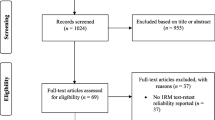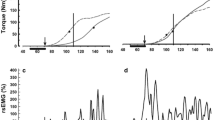Abstract
The device validity, intra-test reliability, and test-retest reliability of the LIDO WorkSETTM (Loredan Biomedical, West Sacramento, California) was studied. Subjects were 30 healthy incumbent workers at a manufacturing and warehousing facility. The results of this study demonstrate a very high degree of device validity in terms of torque measurements, power, and work. In addition, the test protocols were found to be reliable on an intra-test and inter-test basis. Finally, inter-test comparisons were found to be stable over time.
Similar content being viewed by others
References
Roebuck JA Jr. Knob Torque Strength Requirements for Space Suit Glove Operation. Thesis, University of California, Los Angeles, 1965, 253 p.
Garrett JW. Clearance and performance values for the bare-handed and the pressure-gloved operator. Aerospace Medical Research Laboratories, Wright-Patterson AFB, Ohio, 1966, 154 p.
Springer W, Streimer I. Work and force producing capabilities of man [Abstract], Seattle, Washington: Boeing Airplane Company Doc. No. D2-90245, 1962, 54 p.
Matheson LN, Ogden LD. Work tolerance screening. Rehabilitation Inst of Southern Calif., Trabuco Canyon, California, 1983.
Fess EE. Documentation: Essential elements of an upper extremity assessment battery. In Hunter JM, Schneider LH, Mackin EJ Callahan AD, eds.Rehabilitation of the hand (2nd Ed.). St. Louis: The C. V. Mosby Company, 1984, 49–78.
Schmidt RT, Toews JV. Grip strength as measured by the Jamar dynamometer.Arch Phys Med Rehab 1970; 51: 321–327.
Flood-Joy M, Mathiowetz V. Grip strength measurement: A comparison of three Jamar dynamometers.Occup Ther J Res 1987; 7: 235–243.
Kraft GH, Detels PE. Position of function of the wrist.Arch Phys Med Rehabil 1972; 53: 272–275.
Pryce JC. The wrist position between neutral and ulnar deviation that facilitates maximum power grip strength.J Biomech 1980; 13: 505–511.
Adams SK, Peterson PJ. Maximum voluntary hand grip torque for circular electrical connectors.Hum Fact 1988; 30(6): 733–745.
Mathiowetz V, Rennells C, Donahoe L. Effect of elbow position on grip and key pinch strength.J Hand Surg 1985; 10A: 694–697.
Kuzala EA, Vargo MC. The relationship between elbow position and grip strength.Am J Occup Ther 1992; 46(6): 509–512.
Matheson LN, Anzai D, Niemeyer LO, Grant J.The LIDO WorkSET cookbook. West Sacramento, California: Loredan Biomedical, 1991.
Author information
Authors and Affiliations
Rights and permissions
About this article
Cite this article
Matheson, L.N., Mangseth, G., Segal, J.H. et al. Validity and reliability of a new device to simulate upper extremity work demands. J Occup Rehab 2, 109–122 (1992). https://doi.org/10.1007/BF01077183
Issue Date:
DOI: https://doi.org/10.1007/BF01077183




